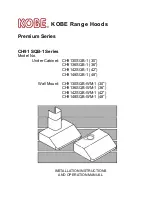
10
combustible materials. These appliances must discharge the combustible products into the appropriate hoods, or similar
devices, connected to a flue of proven efficiency, or they may be connected directly to an outdoor vent.
Failing this, the use of an extractor fan is permitted, connected directly to an external area, with sufficient capacity, which
will then be increased by the exchange of air necessary for the welfare of the workers under current regulations,
approximately 35 m³/h for each kW of gas power installed.
2.4
Connecting up gas
Check on the rating plate (Fig. 1), under the fires on the left-hand side, that the appliance has been tested and approved
for the type of gas that the user uses.
Check that the nozzles on the appliance are suitable for the available gas supply.
Check on the rating plate that the pressure reducer is adequate to the appliance’s gas supply
If gas supply pressure deviates by more than 10% from nominal pressure, fit a pressure regulator upstream of the
appliance to ensure that nominal pressure is maintained.
Do not reduce the diameter of the pipe between the reducer and the appliance.
Fit a gas filter upstream of the pressure regulator in order to optimise operating efficiency.
2.5
Electrical connection
The appliances in the series .....C or ….E are delivered with a power cable without a plug or even without a cable. A
correct connection must observe the laws in force and must be carried out by connecting a standardised plug to the
cable, knowing that the yellow-green wire is the earth wire. If a direct connection to the mains is required, an omnipolar
switch has to be installed between the appliance and the mains. The switch is to be dimensioned for the load and its
contacts must have a minimum opening distance of 3 mm. The yellow-green earth wire must not be interrupted by the
switch.
NOTE: the type of connection cable is indicated in TABLE 3.
The supply terminal board is positioned under the right-hand panel of the cooker.
UNIPOTENTIAL
The appliance must be connected to a unipotential system.
The terminal provided is situated at the rear, near the cable inlet, and is marked by a label.
3. TECHNICAL FEATURES (Relating to the GAS part)
The data plate is positioned on the base of the cabinet or on the panel under the oven.
4. OPERATION WITH SUPPLY GAS IDENTICAL TO THAT AVAILABLE
Check whether the indications on the data plate correspond to the gas distributed. Also check the correspondence of
what is indicated below.
4.1
Checking the supply pressure (Fig. 2)
The supply pressure must be measured by means of a pressure gauge with a U-shaped pipe or of the electronic type with
minimal grading of 0.1 mbar.
Unscrew the screw “A” from the pressure tap “B”.
Position the pressure gauge.
Switch on the appliance and check whether the pressure is the one intended: if not check on the cause.
At the end of the operation, reassemble the appliance and check on the connection
ATTENTION: If the pressure measurement is not within the thresholds stated in table 4, instead of installing the appliance
you should contact your gas provider to report a fault with your mains supply.
Close the gas valve, disconnect the pressure measurement device, do up the screw you had previously undone and
close the front panel.
4.2
Regulating the primary air
The primary air must be regulated taking into account the indications of tables 2.
4.3
Regulating the pilot flame
Regulate and check that the flame envelops the thermocouple and that the appearance of the same is correct. If this is
not the case, check that the injectors mounted are the right ones (see tables 2).
4.4
Checking the main burner
Switch on the appliance and check that the flame, lighting and regulation of the minimum are correct. Otherwise the
injectors and the position of the primary air have to be checked (see tables 2).
5. REGULATION
FOR OPERATION WITH OTHER TYPES OF GAS
To carry out this operation, for example in order to change from natural to liquid gases, the injectors of the main burners
and of the pilot flames have to be changed and the by-pass of the minimum regulated (see tables 2).
All the injectors required for regulation are supplied in a small bag together with the appliance. The injectors of the main
burners are marked in hundredths of a millimetre, while those of the pilot flame have a reference number.
5.1
Replacing the injectors of the main burners
Remove the grilles, drip collector basins, body and head of the burners.
5.1.1
Pilot flame (Fig. 3)
If the pilot flame has been regulated correctly it should envelop the thermocouple and have a perfect exterior appearance.
If this is not the case, unscrew the screw “C” and check that the injectors installed are the right ones (see tables 2).
It is not necessary to regulate the primar
y air for the pilot flame “D”
5.1.2 Main burner (Fig. 4)
The primary air is regulated correctly if the stability of the flames is ensured, i.e. if flame lifts do not appear with the burner
cold and if there is no flame return with the burner hot.












































